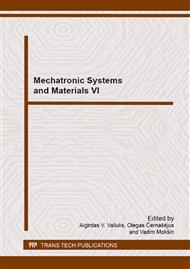p.224
p.230
p.239
p.244
p.251
p.257
p.264
p.271
p.277
Numerical Modeling of the Phenomena of Frictional Coupling between Wheel and Rail to Describe and Verify the Operation of Surface Condition Detector
Abstract:
Presentation of the numerical model describing a design and functionality of the prototype of surface condition detector is the paper subject. The detector, by monitoring the frictional coupling between so-called “tracking wheel” of the dedicated measuring transducer and a rail can analyse the condition of rail surface (presence of any factor that can deteriorate friction coefficient) [1]. Signal generated at the detector outlet, carrying information about local condition of rail surface, can be used to adjust braking torque of vehicles or machines moving on a track. Authors expect that implementation of the method will eliminated dangerous elongation of braking distance of rail vehicles in the result of loss of adhesion. Structure of detector of rail surface condition is described and its principle of operation is presented in a form of numerical model. Results of numerical simulations are given and they are compared with the measurements taken on the testing facility in real conditions.
Info:
Periodical:
Pages:
251-256
Citation:
Online since:
January 2015
Authors:
Price:
Сopyright:
© 2015 Trans Tech Publications Ltd. All Rights Reserved
Share:
Citation:


